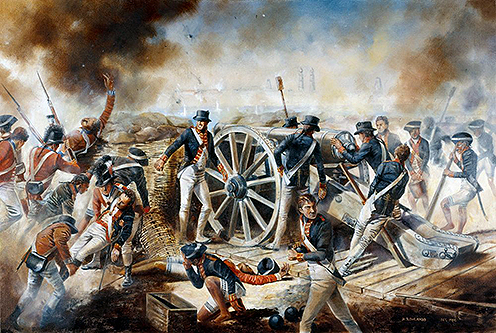| |
« Click on Picture to
Return » |
|
|
 |
|
The Siege of Seringapatam, 1799
18-pounder gun in action during the siege of Seringapatam.
Operations in front of Seringapatam began on 4th April 1799, and culminated with the crossing of the South Cauvery river by the infantry, the successful assault through the breach and the capture of the fortress on the afternoon of 4th May.
Besides field artillery, the army commanded by Lieutenant-General George Harris included siege artillery consisting of two iron 24-pounders, thirty iron 18-pounders, eight iron 12-pounders and three 8-inch brass howitzers. Siege guns were much heavier than field guns of the same bore size and were made of iron rather than brass on account of the cost. Each heavy gun was drawn by 40 or more bullocks (formed four abreast) assisted by a large female elephant for each pair of guns. They could keep up with the infantry on a march even in moderately rough country. The army contained 608 European gunners and 1,483 Indian gun lascars.
The pieces of artillery used in the British and Honourable East India Company's armies were almost all standard Woolwich types. Only the wooden gun carriages were made in India. All the heavier siege guns had a Muller or 'bracket'-type carriage with a double trail; the cheek pieces run back parallel to each other and are joined only by brackets or a transom.
The painting was commissioned by 40 Field Regiment RA in 1986. One of the regimentís batteries was 38 (Seringapatam) Battery which could trace its history back to the 4th Company, Bombay Artillery, formed in 1768. The battery is currently in suspended animation.
Medium: Oil on Canvas
Printed image size(s): B2 only (58 x 38 cm)
Owner: Royal Regiment of Artillery
Price(s): £70
|
|
| |
|
|
|
|
|
|
|
|
|
|
|
|
|
|
|
|











